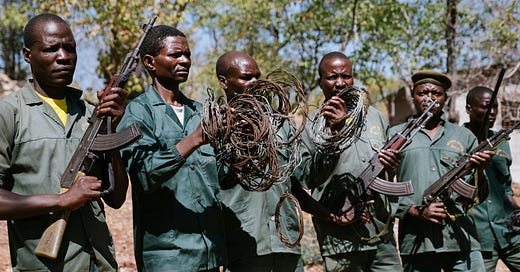Killing the Shepherd
This heavy-handed documentary about poaching and other environmental challenges in Zambia sometimes wades into infomercial mode.
Poaching may seem like a distant problem to those of us in America, but in Africa it’s a serious challenge that not only unbalances ecosystems but causes widespread misery for human beings. This issue is explored in the documentary “Killing the Shepherd,” written, directed, photographed and narrated by Ta Opre.
It’s a compelling subject, though Opre’s heavy-handed storytelling tactics tend to push the movie into infomercial mode. It times it feels more like a call to arms than a journalistic exploration of an important topic.
The documentary looks at the poaching issue in central Zambia, especially in and around the Luona district. Rugged and mountainous, the area is blessed with an abundance of wild game but the soil and conditions make crop agriculture difficult. The local tribes survived on hunting for years, but as poaching has decimated the animal stocks, the people have suffered with crushing poverty, lack of education, businesses and crime.
Desperate families marry off their young daughters to older men, essentially selling them into a life of indentured servitude. Men turn to drink or harmful charcoal-making that decimates the forests. Or they turn to poaching themselves, setting up snares to catch animals they can cut up into bushmeat that is sought after as a delicacy in the cities. The elders struggle to find resources and answers to help their people.
The title comes from the elderly chief of the local tribe, Lucia Tembo, who recognizes the consequences of these poor choices and works to find new avenues. She partners with a hunting company, Makasa Safaris Zambia, to control the poaching and remove the conditions that make it tempting as a source of income.
About halfway through the documentary, the chief suddenly dies despite being in good health, and one of her retainers is suspected of poisoning her. But because nothing can be proven, nothing happens. A younger woman with similar passion, an accountant by training, takes over — but everyone fears for her safety as well.
Two central figures in the doc are Roland Norton and his son, Alistair, who run the safari. It may seem strange for people who make their living from hunting beasts to be the ones to fight poaching, but as the documentary lays out they do what they do for their own benefit, as well as the local people. By reducing poaching and allowing the animal stocks to rebound, they can resume the safaris that had been abandoned 20 years ago, bringing in money from tourists, hunting licenses and so on.
Over time we see a school and clinic being constructed in the district from the hunting income, so it seems the plan is having the positive intended effect.
There is a bit of an uncomfortable feeling of white outsiders coming in to “save” the poor Blacks, though the elder Norton makes clear he was raised in this country and intends to stay. He wants to work with the people, not become their overlord. When one woman asks if he is going to leave after making his money, Norton instructs her to dig a hole under a shady tree nearby, and to bury his body there when he dies.
Some of the most compelling footage involves Blackson, a local poacher who demonstrates the technique of how he bends wire into snares to catch animals. With multiple children to support and no other jobs or industry, the bushmeat he obtains keeps them from starving.
Later, the poacher becomes one of the game wardens outfitted by the safari to more effectively combat the wanton killing of animals, and it seems like a redemptive story. But disturbing accusations later surface about his true intent.
The movie also isn’t helped by Opre himself frequently appearing onscreen to narrate the story and opine. He has a fine, deep voice made for voiceover work. (I kept thinking to myself he would break out into “In a world…” intonations.) But it comes across as self-aggrandizing, not to mention bringing the storytelling to a stop.
There’s plenty to admire about “Killing the Shepherd.” It’s a film project that seems to have its heart in the right place, though it would have benefited from less wearing of it on its sleeve.





